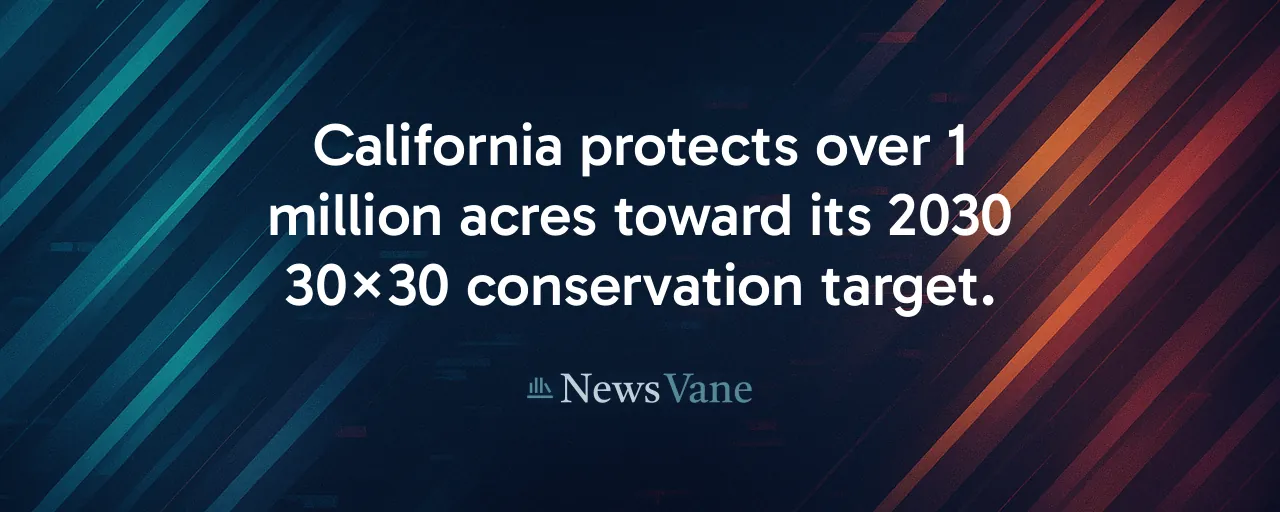A Million Acres and Counting
California's latest conservation milestone hit the headlines in July 2025, with over one million acres of land and coastal waters newly protected in just a year. That's an area the size of Glacier National Park, pushing the state closer to its ambitious target of conserving 30 percent of its lands and waters by 2030. Governor Gavin Newsom announced the progress in Sacramento, framing it as a bold step for biodiversity and public access. The numbers raise a question: can California protect its natural heritage without tipping the scales against economic and social needs?
The state's 30x30 initiative, launched in 2020, aims to safeguard ecosystems while expanding outdoor access and honoring tribal stewardship. The 2025 progress report shows 26.1 percent of lands and 21.9 percent of coastal waters now under long-term protection. With four years left, the goal feels within reach. Conservation needs to deliver for both nature and people.
This push comes amid tension with federal policies. Newsom's administration recently criticized proposed cuts to National Park staffing and programs under President Trump's Department of the Interior, warning of reduced public safety and access. California's response has been to double down on state-led conservation, from marine sanctuaries to tribal co-management agreements. The state's not waiting for federal support, but the path forward demands cooperation across divides.
Why Conservation Matters Now
Protecting large swaths of land and sea is important for saving scenic views. Research shows well-managed conserved areas store more carbon, reduce wildfire severity, and protect water supplies. A 2023 study in Nature found that intact ecosystems cut downstream firefighting costs by up to 20 percent. California's ecosystems also generate over $30 billion annually in benefits, from clean water to tourism, according to economic valuations. These numbers make a strong case for conservation as a practical investment and an environmental ideal.
Biodiversity loss adds urgency. Globally, species are declining at unprecedented rates, and California's diverse habitats are no exception. The state's 30x30 plan targets key wildlife corridors, wetlands, and coastal zones to stem this tide. Meanwhile, climate change intensifies droughts and megafires, making resilient ecosystems a firewall against disaster. Conserving land now could save billions in future recovery costs, provided the effort is strategic and inclusive.
Public access is another driver. Over $1 billion in state funds since 2020 has gone to parks and trails, especially in underserved urban areas. Projects like new coastal access points and community green spaces aim to make nature reachable for all Californians. Some rural communities worry about lost jobs or tax revenue from restricted land use. Striking a balance between ecological gains and economic stability is the state's next hurdle.
Tribal Wisdom Shapes the Future
One of the initiative's standout moves is its partnership with Native American tribes. Agreements like the Karuk Tribe's 2025 cultural burning pact empower tribal leaders to restore landscapes using Traditional Ecological Knowledge. Over 150 years after California banned Indigenous fire practices, these deals mark a step toward healing historical wrongs. Land-back agreements have also returned ancestral territories to tribes like the Yurok and Esselen, blending conservation with cultural revitalization.
These partnerships offer substantial benefits. Studies show Indigenous-managed lands often have higher biodiversity than conventional reserves. Tribal fire practices, for instance, reduce fuel loads and prevent megafires more effectively than some modern methods. With $180 million in state grants supporting tribal-led projects, California's betting on this approach to meet its 30x30 goals. Scaling these efforts requires trust, funding, and respect for tribal sovereignty.
The Economic Tightrope
Conservation isn't cheap. California has spent $1.3 billion on 30x30 since 2022, with voters approving a $10 billion climate bond in 2024 to keep the momentum. These funds have leveraged another $1 billion from federal and private partners, a testament to cross-sector collaboration. Critics highlight trade-offs, as restricted lands can curb timber, mining, or housing development, hitting rural economies hard. In 2024, wildfire suppression alone cost the state $4 billion, raising questions about whether new protected areas stretch resources too thin.
On the flip side, conserved lands fuel tourism and recreation, industries that employ thousands. Flexible tools like conservation easements let private landowners protect habitats while keeping their land productive. These voluntary agreements could bridge the gap, preserving biodiversity and allowing working landscapes to continue. It is important to ensure funds reach rural communities to offset losses and support local jobs.
Navigating the Road Ahead
California's undeniable progress faces looming challenges. Defining what counts as "conserved" remains murky, and some fear numeric targets prioritize acreage over ecological health. Staffing shortages and wildfire risks threaten long-term management, while jurisdictional clashes with federal agencies complicate planning. Transparency tools like the CA Nature GIS platform help; bipartisan oversight could ensure accountability and build trust across stakeholder groups.
Compromise offers a way forward. Expanding easements and funding active forest management could satisfy both environmental and economic goals. Allocating climate-bond funds to rural development grants might ease local concerns, while clear metrics for biodiversity and access can keep the initiative on track. California's 30x30 plan is a test case for balancing nature, culture, and livelihoods, and its success hinges on collaboration.
The state's journey to 30 percent conservation is a policy goal that also offers a chance to redefine how we coexist with the natural world. With careful planning and inclusive dialogue, California could set a global standard for protecting landscapes while uplifting communities. The next four years will show whether ambition can translate into lasting change.
